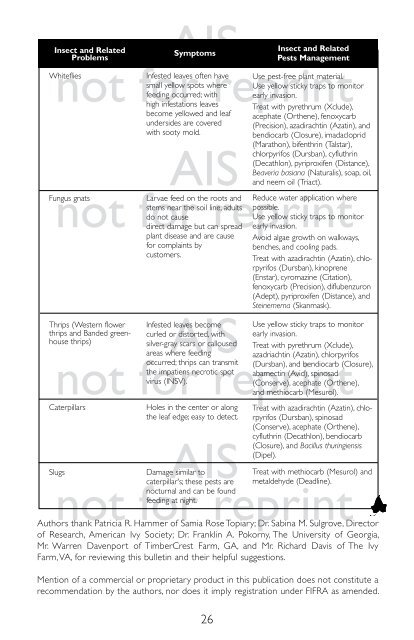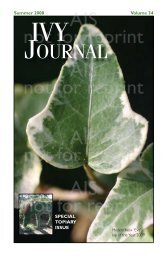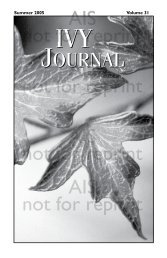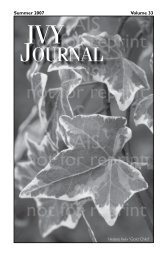2003 | Volume 29 - American Ivy Society
2003 | Volume 29 - American Ivy Society
2003 | Volume 29 - American Ivy Society
You also want an ePaper? Increase the reach of your titles
YUMPU automatically turns print PDFs into web optimized ePapers that Google loves.
AIS<br />
not for reprint<br />
Insect and Related<br />
Problems<br />
Whiteflies<br />
Symptoms<br />
AIS<br />
not for reprint<br />
Fungus gnats<br />
AIS<br />
not for reprint<br />
Thrips (Western flower<br />
thrips and Banded greenhouse<br />
thrips)<br />
Caterpillars<br />
AIS<br />
not for reprint<br />
Slugs<br />
Infested leaves become<br />
curled or distorted, with<br />
silver-gray scars or calloused<br />
areas where feeding<br />
occurred; thrips can transmit<br />
the impatiens necrotic spot<br />
virus (INSV).<br />
Holes in the center or along<br />
the leaf edge; easy to detect.<br />
Damage similar to<br />
caterpillar's; these pests are<br />
nocturnal and can be found<br />
feeding at night.<br />
Authors thank Patricia R. Hammer of Samia Rose Topiary; Dr. Sabina M. Sulgrove, Director<br />
of Research, <strong>American</strong> <strong>Ivy</strong> <strong>Society</strong>; Dr. Franklin A. Pokorny, The University of Georgia,<br />
Mr. Warren Davenport of TimberCrest Farm, GA, and Mr. Richard Davis of The <strong>Ivy</strong><br />
Farm, VA, for reviewing this bulletin and their helpful suggestions.<br />
Mention of a commercial or proprietary product in this publication does not constitute a<br />
recommendation by the authors, nor does it imply registration under FIFRA as amended.<br />
26<br />
Insect and Related<br />
Pests Management<br />
Infested leaves often have Use pest-free plant material.<br />
small yellow spots where Use yellow sticky traps to monitor<br />
feeding occurred; with early invasion.<br />
high infestations leaves Treat with pyrethrum (Xclude),<br />
become yellowed and leaf acephate (Orthene), fenoxycarb<br />
undersides are covered (Precision), azadirachtin (Azatin), and<br />
with sooty mold.<br />
bendiocarb (Closure), imadacloprid<br />
(Marathon), bifenthrin (Talstar),<br />
chlorpyrifos (Dursban), cyfluthrin<br />
(Decathlon), pyriproxifen (Distance),<br />
Beaveria basiana (Naturalis), soap, oil,<br />
and neem oil (Triact).<br />
Larvae feed on the roots and Reduce water application where<br />
stems near the soil line; adults possible.<br />
do not cause<br />
Use yellow sticky traps to monitor<br />
direct damage but can spread early invasion.<br />
plant disease and are cause Avoid algae growth on walkways,<br />
for complaints by<br />
benches, and cooling pads.<br />
customers.<br />
Treat with azadirachtin (Azatin), chlorpyrifos<br />
(Dursban), kinoprene<br />
(Enstar), cyromazine (Citation),<br />
fenoxycarb (Precision), diflubenzuron<br />
(Adept), pyriproxifen (Distance), and<br />
Steinemema (Skanmask).<br />
Use yellow sticky traps to monitor<br />
early invasion.<br />
Treat with pyrethrum (Xclude),<br />
azadriachtin (Azatin), chlorpyrifos<br />
(Dursban), and bendiocarb (Closure),<br />
abamectin (Avid), spinosad<br />
(Conserve), acephate (Orthene),<br />
and methiocarb (Mesurol).<br />
Treat with azadirachtin (Azatin), chlorpyrifos<br />
(Dursban), spinosad<br />
(Conserve), acephate (Orthene),<br />
cyfluthrin (Decathlon), bendiocarb<br />
(Closure), and Bacillus thuringiensis<br />
(Dipel).<br />
Treat with methiocarb (Mesurol) and<br />
metaldehyde (Deadline).





